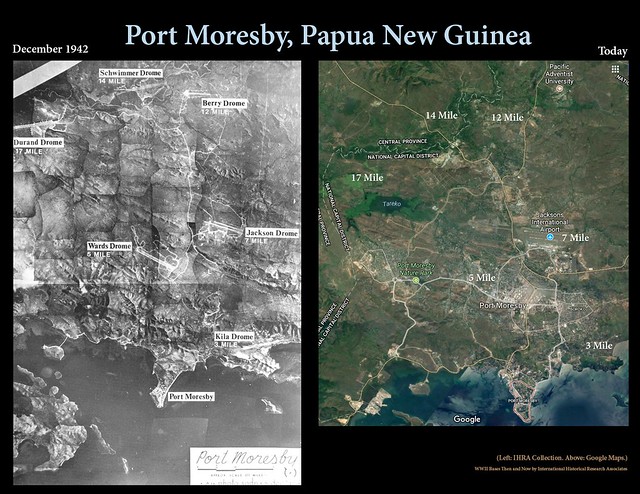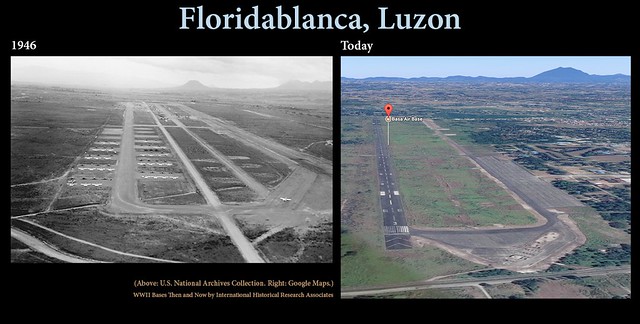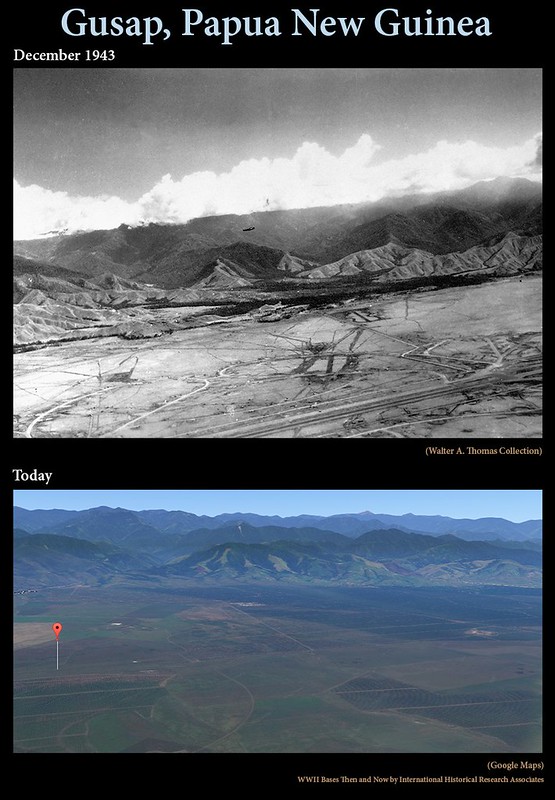Port Moresby
The town that would later become the capital city of Papua New Guinea, Port Moresby, was a major staging base for the Allies during World War II. Port Moresby’s air fields, named for their distance from the city, included: 3 Mile (Kila Kila), 5 Mile (Ward), 7 Mile (Jackson), 12 Mile (Berry), 14 Mile (Schwimmer), and 17 Mile (Durand). It was crucial for the Allies to hold onto this territory, as it was the last piece of land between the Japanese to the north and Australia to the south. The city’s occupants were subject to many Japanese bombing raids until September 1943. Postwar, Port Moresby transformed from an Australian territory to the Papua New Guinea capital in 1975. Today, all that remains of World War II are artifacts and steel matting from the runways.

Click to enlarge. In the photo on the left, taken from Rampage of the Roarin’ 20’s, is the Port Moresby complex as it appeared in December 1942. At right is Port Moresby today, taken from Google Maps.
Floridablanca
Translated from Spanish as “white flower,” Floridablanca was settled as a Spanish mission in 1823. Not much is known about the area’s history, but it was taken over by the Japanese during World War II, then liberated once the Allies moved that far north. The 312th Bomb Group and 348th Fighter Group both used the air base on Floridablanca for a short time. The Philippine Air Force now uses the base and it has been renamed Basa Air Base.

Click to enlarge. In the photo on the left, taken from Rampage of the Roarin’ 20’s, is Floridablanca as it appeared in 1946. At right is Floridablanca today, taken from Google Maps.
Owi Island
Owi’s only inhabitants before World War II consisted of two families, one at each end of the small island. Shortly after the arrival of Allied forces in 1944, the natives left. It took about three weeks to build the airstrip, which consisted of coral, a difficult surface to land on when it was wet. Owi was used between June and November 1944, then abandoned as U.S. forces pushed north. Traces of the runway can still be seen today.

Click to enlarge. In the photo at the top, taken from an upcoming book, is Owi Island as it appeared in August 1944. Above is Owi Island today, taken from Google Maps.
Finschhafen
In 1885, Finschhafen was settled by the German New Guinea Company. About 15 years later, it was abandoned after disease spread rapidly among the settlers and resulted in the failure of two different colonization attempts. At some point before World War II started, Lutherans built a mission station on Finschhafen. The Japanese took over the area on March 10, 1942 and held it until Australian forces moved in and captured Finschhafen on October 2, 1943. Allied forces expanded the base and used it until the end of the war. After the war ended, a huge hole was dug and much of the leftover equipment was buried. These days, Finschhafen is a quiet location.

Click to enlarge. In the undated photo at the top is Finschhafen sometime around World War II. Above is Finschhafen today, taken from Google Maps.
Gusap
Previously uninhabited, Gusap was built up into an eight-runway airfield by U.S. Army engineers. It was used from October 1943 to July 1944 by several units that included the 49th Fighter Group and 312th Bomb Group. This location was ideal for staging missions by fighters and light bombers. After the war was over, remaining aircraft were scrapped. Today, only one of the eight strips is still being used by aircraft and is noted by the balloon in the right image. The rest of the area has been turned into a cattle ranch. With the radical transformation of Gusap, the exact location of the airfields seen in the left image has become unknowable.

Click to enlarge. In the top photo, taken from Rampage of the Roarin’ 20’s, is part of Gusap’s airfields as they appeared in December 1943. Above is Gusap today, taken from Google Maps.
Sources and additional reading:
https://www.pacificwrecks.com/provinces/png_port_moresby.html
https://www.britannica.com/place/Port-Moresby
https://www.pacificwrecks.com/airfields/philippines/floridablanca/index.html
http://en.wikipilipinas.org/index.php/Floridablanca,_Pampanga
https://en.wikipedia.org/wiki/Owi_Airfield
https://www.pacificwrecks.com/airfields/indonesia/owi/index.html
https://www.pacificwrecks.com/provinces/png_finschafen.html
http://engineersvietnam.com/engineers/WWII/owi.htm
https://en.wikipedia.org/wiki/Finschhafen
https://www.britannica.com/place/Finschhafen
https://www.pacificwrecks.com/airfields/png/gusap/index.html

Thank you for these before and after shots. How time changes things.
LikeLiked by 1 person
You are most welcome. It’s so interesting to see how areas touched by war change over the years. Have you seen our other two before and after posts?
LikeLiked by 1 person
We haven’t seen those post yet but now we will be finding them.
LikeLike
I wish my father were around to see all the information shared on lone about the Pacific!! He always felt very few even knew the Army was out there. He would have loved this post!!
LikeLiked by 1 person
Thanks! Being so far away from everything must have felt so isolating…not to mention feeling forgotten while the “Europe first” policy was in full force.
LikeLiked by 1 person
Hey – isn’t THAT the truth!!
LikeLike
It’s fascinating to see the places now. Some of them are ripe for excavations, who knows what history lies beneath the surface.
LikeLiked by 1 person
It is fascinating! Not sure how much excavating has been done in these areas compared to the UK.
LikeLiked by 1 person
Very little I suspect!
LikeLike
Familiar places in my uncle’s log book.
LikeLike